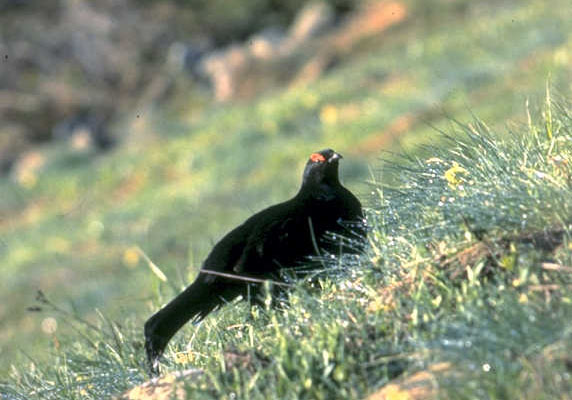- Caucasian Black Grouse
Taxobox
name = Caucasian Black Grouse

status = NT
status_system = iucn3.1
regnum =Animal ia
phylum = Chordata
classis = Aves
ordo =Galliformes
familia =Tetraonidae
genus = "Tetrao "
species = "T. mlokosiewiczi"
binomial = "Tetrao mlokosiewiczi"
binomial_authority = Taczanowski, 1875The Caucasian Black Grouse ("Tetrao mlokosiewiczi") is a large
bird in thegrouse family. It is closely related to theEurasian Black Grouse ("T. tetrix"). It occurs in extreme southwesternEurope and adjacent regions. The scientific name of this bird commemorates the Polish naturalistLudwik Mlokosiewicz .As with many gamebirds, the cock (male) is larger than the hen (female), measuring 50-55 cm compared to her length of 37-42 cm. The cock is very distinctive, with all-black plumage, apart from red eyebrows, and a long, deeply forked tail. The female Caucasian Black Grouse is grey with dark barring, and has a cackling call.Madge "et al." (2002)]
The Caucasian Black Grouse is a sedentary
species , breeding in theCaucasus Mountains and northeastTurkey on open slopes with low "Rhododendron " or other scrubs. These bird have a group display or lek in early spring. Unlike the male Eurasian Black Grouse, the Caucasian Black Grouse display is almost mute, but a thin whistling is produced by the cock's wings. The hen lays up to 10 eggs in a ground scrape and takes all responsibility for nesting and caring for the chicks, as is typical with gamebirds.This is perhaps the least-known of all grouse in the world, and it was formerly classified as
Data Deficient by theIUCN [BLI (2004)] . Recent research shows that it is declining to some extent, and it is consequently listed as aNear Threatened species in 2008 [BLI (2008)] .Footnotes
References
*|year=2004|id=21670|title=Tetrao mlokosiewiczi|downloaded=12 May 2006
* (2008): [http://www.birdlife.org/action/science/species/global_species_programme/whats_new.html [2008 IUCN Redlist status changes] . Retrieved 2008-MAY-23.
* (2002): "Pheasants, partidges and grouse : a guide to the pheasants, partridges, quails, grouse, guineafowl, buttonquails and sandgrouse of the world". Christopher Helm, London. ISBN 0-7136-3966-0
Wikimedia Foundation. 2010.
